Meet us! Adventure Van Expo, May 10–11 in Ventura
Winterize Your Camper Van:
Expert Tips for Cleaning and Storage
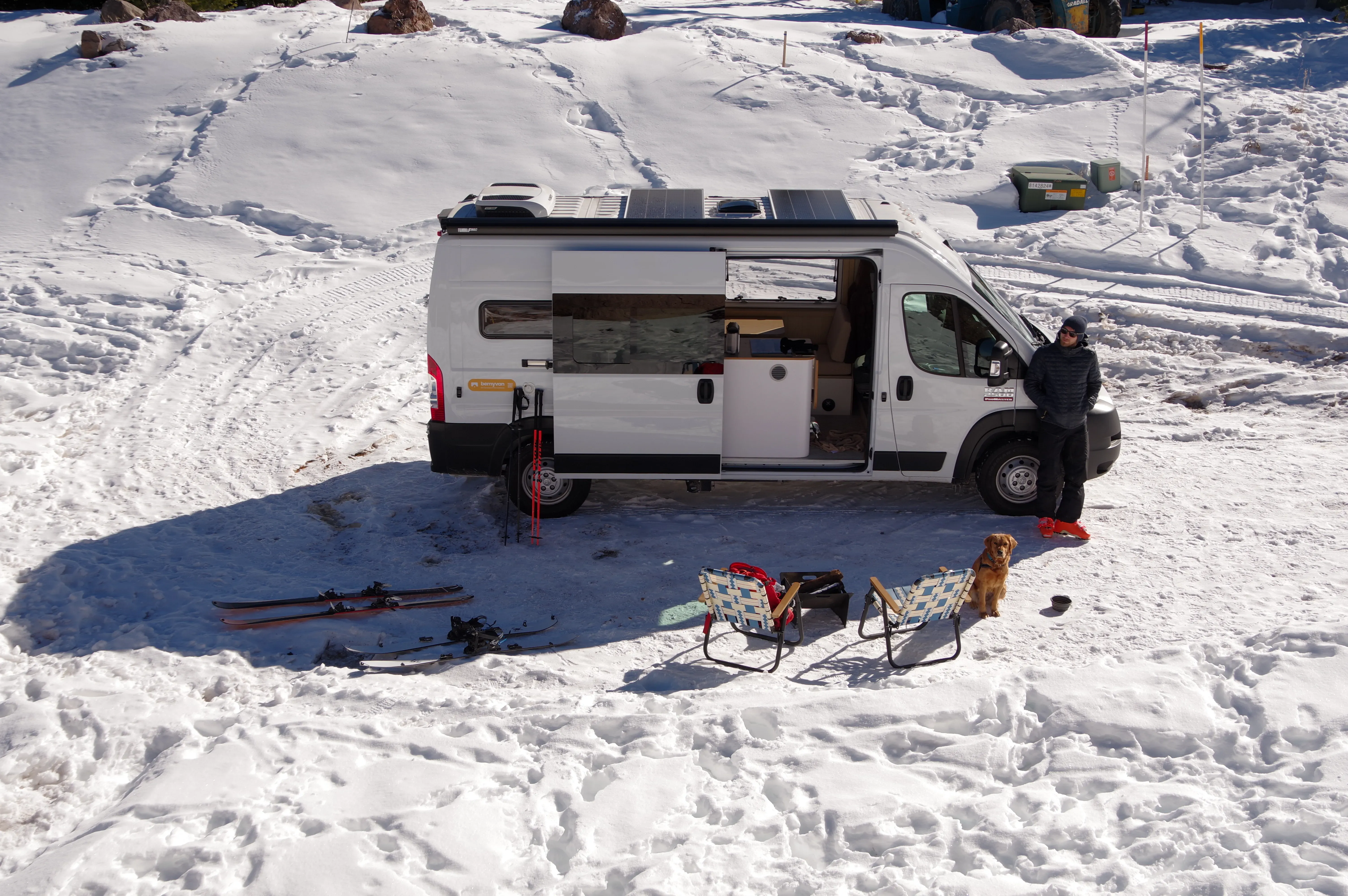
If you’re not a year-round vanlifer and you live in a colder climate, winterizing your Noovo camper van is a crucial step to ensure that it survives the cold season without any damage. As temperatures drop, various components of your camper van become vulnerable to the harsh winter conditions. From pipes and batteries to moisture control, you’ll want to make sure you’ve checked each component and properly prepared your van for wet weather and freezing temps.
In this expert guide, we will walk you through the importance of winterizing your campervan, offer a step-by-step winterizing checklist and considerations for storage, and then explore the essential process of transitioning your van back into action come spring! You’ll be hitting the road faster than ever with a road-ready van.
The Importance of Winterizing Your Camper Van
Benefits of Winterizing Your Van
Winterizing your van is not just about protecting it from the cold or the elements, it is a comprehensive approach to preserving the longevity and functionality, as well as maintaining the value of your home on wheels. The benefits of winterization include safeguarding against potential damage caused by freezing temperatures, preventing rust and corrosion, and ensuring that your camper van is ready for the next adventure when spring arrives. With a few easy steps, you can prevent burst pipes, damaged solar panels, and unwanted mold and mildew.
When is the Best Time to Prepare Your Van for Winter?
It’s always tough to tuck your Noovo van away for the winter. And if you still want to keep using it occasionally, you might want to consider renting it when not in use! But for those who know their van will be hanging out until the sunshine and warm temps return, it is important to get it winterized as soon as possible. Timing is critical when it comes to winterizing your campervan, and can be hard to know when to do! Ideally, you should start the process before the first frost hits. This ensures that your campervan is well-protected before the winter chill sets in. Waiting too long can lead to unexpected issues, so it's best to be proactive and get your camper van ready ahead of time.
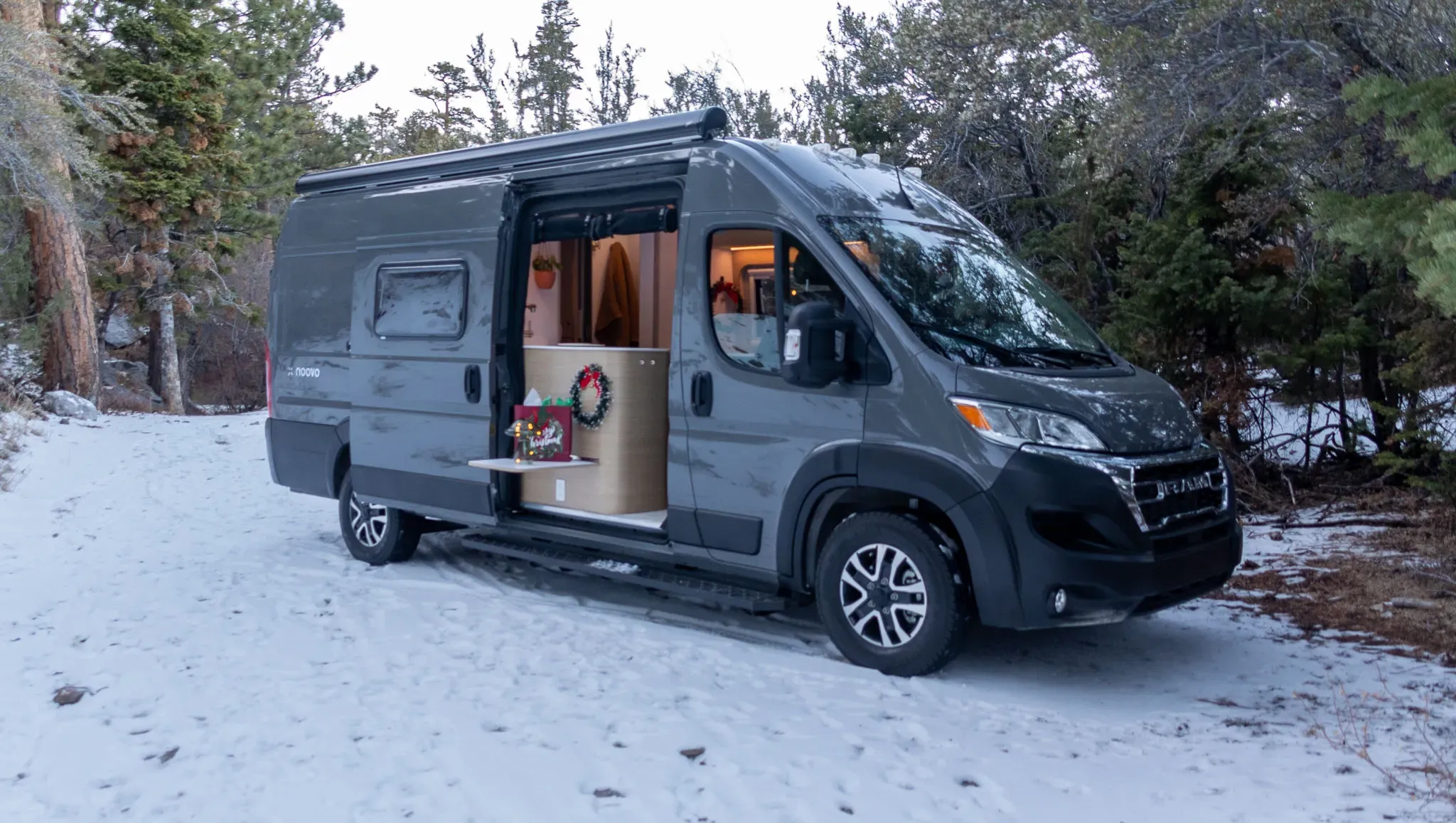
Beautiful Noovo Lite in the snow
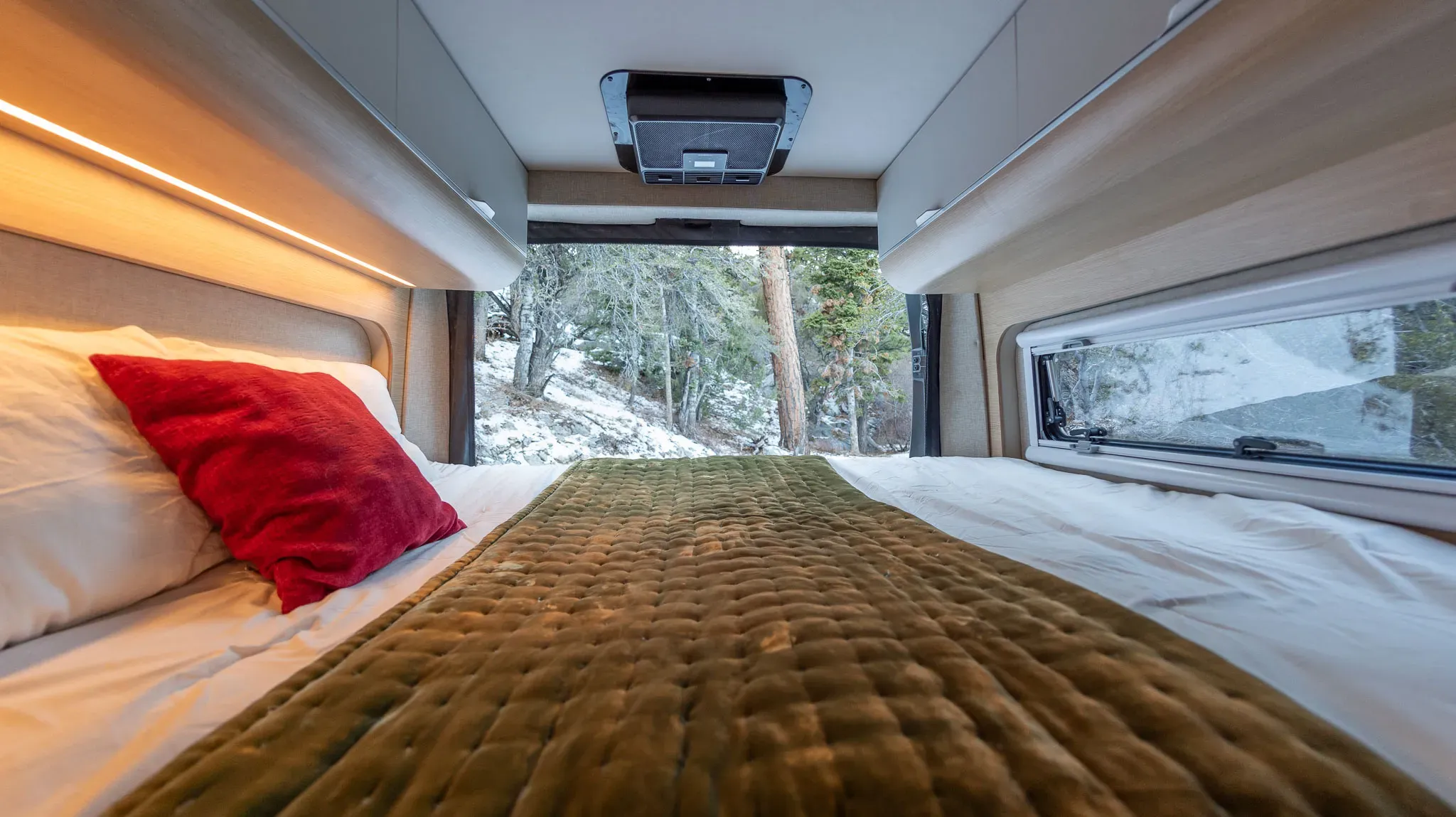
Cosy bedroom with view
Step-By-Step Guide to Winterize Your Camper Van
1) Insulating Your Camper Van
Proper insulation is a key aspect of winterization. It helps maintain a comfortable interior temperature and protects your camper van from the freezing cold. One of our favorite add-on features for Noovo vans is the custom, magnetic window covers that perfectly fit your van windows. These not only insulate in the winter, but are great for keeping out damaging sun rays and the heat in the summer!
Our van walls are very well insulated, but if you have your own campervan consider using Havelock wool for ceilings and walls, as well as weatherstripping for doors and windows, for some extra reinforcement. If you are storing your van outside, don't forget to insulate areas prone to drafts or where moisture or dust could enter, such as vents or gaps around fixtures. Otherwise, if stored inside or somewhere dry, keeping vents open can help reduce moisture build-up. It depends on where you are storing the van and in what kind of climate!
2) Protecting Your Camper Van’s Plumbing in Winter
One of the most vulnerable aspects of your camper van in winter is the plumbing system. Frozen pipes can lead to challenging and costly repairs. To prevent this, drain the water from your system, including the water heater and all sink and shower pipes. Use RV antifreeze to flush out any remaining water and protect against freezing.
3) Preparing Tires and Brakes for Winter Conditions
If you are going to be taking your van out in the winter, quality tires and brakes are critical for safe winter travel. Check your tire pressure regularly, as it tends to drop in cold weather. Consider investing in winter-specific or studded tires for improved traction on snow and ice. Inspect your brakes and replace worn-out pads to ensure optimal stopping power. If you are storing your van for the winter, it is still a good idea to maintain ideal tire pressure as well as start-up your van and reposition it every few weeks to avoid creating flat spots on your tires(this can happen in as quickly as one month!)
4) Battery Maintenance for Cold Weather
Cold weather can significantly affect your camper van's battery performance. Before winter hits, check the battery's charge and top it off if needed. Consider using a trickle charger to maintain a consistent charge during periods of inactivity. Insulate the battery to protect it from the cold, and if possible, store it in a warmer place when not in use. Always make sure to clean any corrosion and ensure safe connections.

5) Essential Winter Accessories: Chains and More
For those who will continue to drive their vans throughout the winter, equip your campervan with essential winter accessories. Snow chains provide additional traction on icy roads, while a sturdy ice scraper and snow brush are essential for keeping your windows clear. Consider carrying a shovel for emergencies and a bag of sand or kitty litter for added traction. Unlike many other rear-wheel drive vans on the market Noovo vans are built on Dodge Ram Promasters with front-wheel drive and are fully capable of tackling slick winter roads. Many of our customers never even have to use their chains, but it’s always good to be prepared!
6) Moisture Control Strategies
Moisture can be a significant issue in winter, leading to mold and mildew. If you live near the ocean or in more humid climates, you probably have already experienced this issue with your other outdoor gear! Use moisture-absorbing products or desiccants inside your campervan. Noovo vans have a Maxxair Fan Deluxe 7500K (with a remote!) to help keep the air in the van flowing. There is also a Maxxair Dome Fan in the shower to help with ventilation and moisture. Ventilation is key, so long as more moisture isn’t getting in, and you can always crack a window if stored in a dry garage. Regularly check for and address any leaks that could contribute to moisture buildup.
7) Post-Trip Care: Drying Out Your Van
After each winter excursion, or periodically throughout winter storage, take the time to thoroughly dry out your camper van. Moisture inside can lead to mold and unpleasant odors, and more work getting rod-ready in the spring. Open windows and vents, use a dehumidifier if necessary, and wipe down surfaces to ensure a dry and welcoming interior. If you happen to cruise through an exceptionally wet adventure, turn on your heater or switch on the fans in your Noovo van to help keep‘er dry!
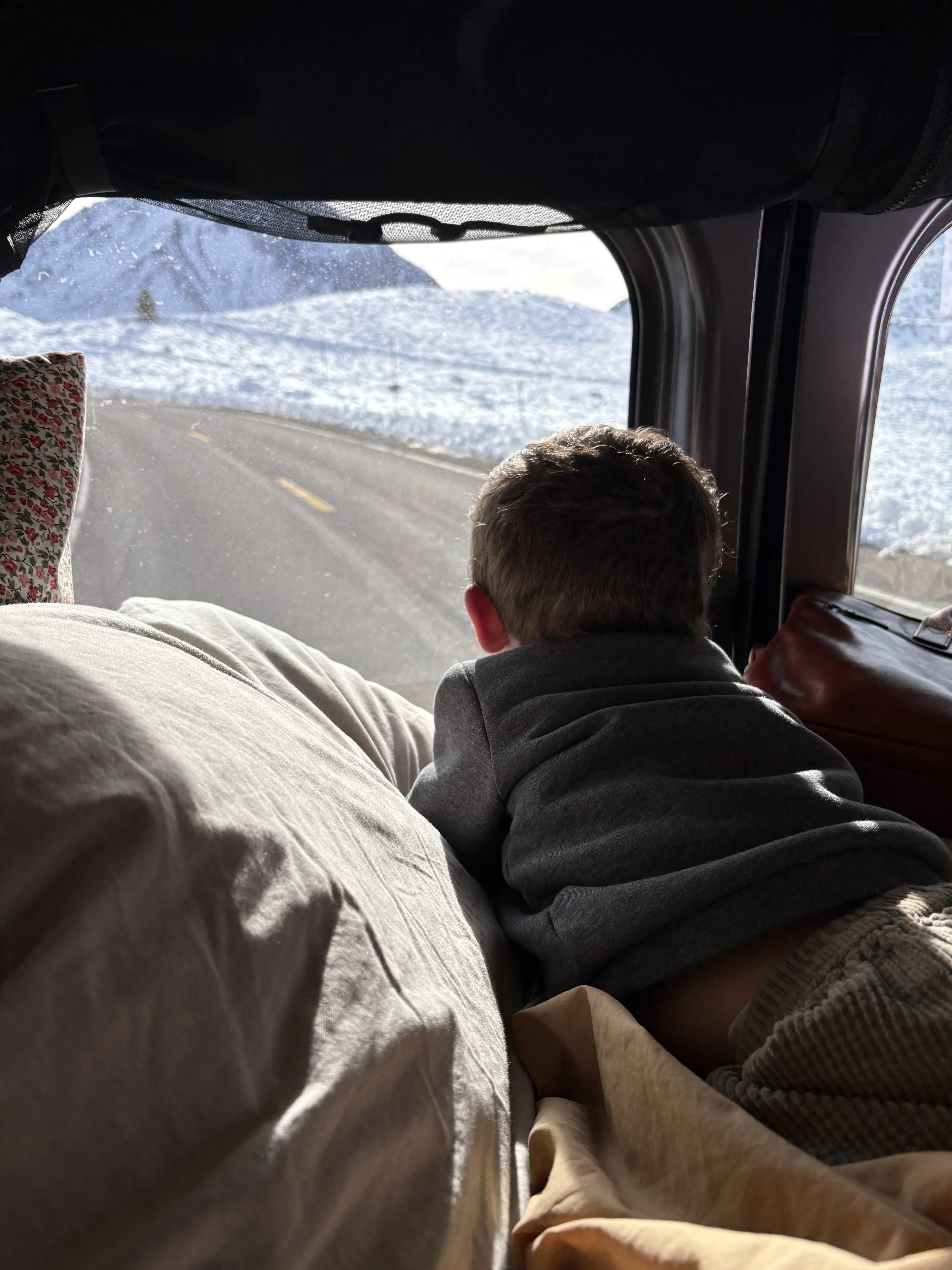
Leon is amazed by the view
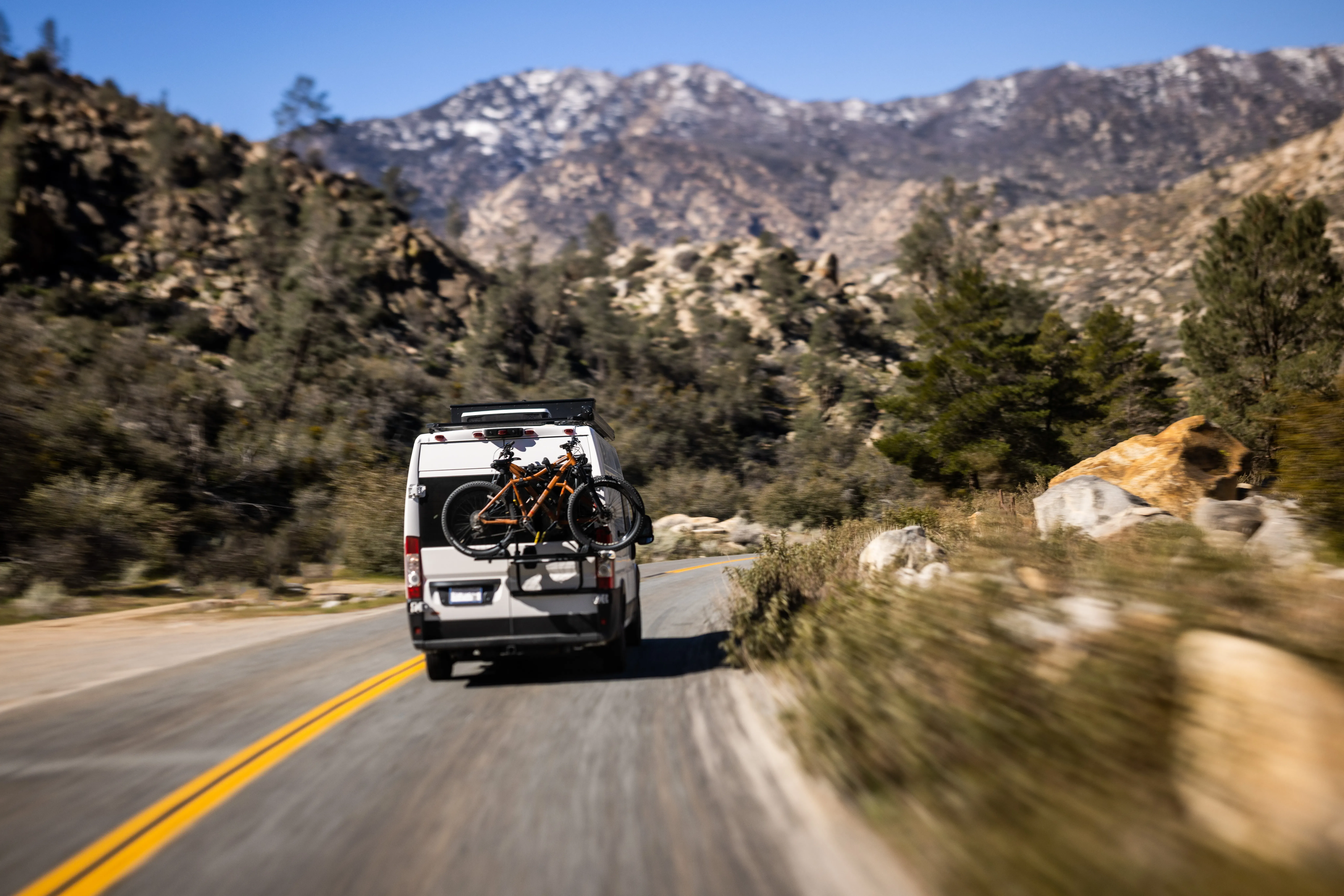
Go on an adventure!
Considerations for Storing Your Camper Van in Winter
Clean Your Van Before Storage
It’s a great idea to thoroughly clean your camper van before storing it for the winter. Remove all food items (even spices so rodents are not attracted!), clean out the fridge and any coolers, scrub the toilet and shower, and vacuum floors and upholstery. Pay attention to hidden corners where crumbs and moisture can accumulate! It’s easy to stay clean and organized in a Noovo van with plenty of storage space, a stowable trash can, and a spacious pantry.
Detailed Winterization of the Plumbing System
For long-term storage, go beyond the basic plumbing winterization. Clean and sanitize the entire system before adding RV antifreeze. Make sure water tanks are empty the Noovo vans offer a generous 40 gallon tank for both fresh and gray!), and you can even use compressed air to remove any remaining water from the pipes. Noovo vans use a Rixen water heater, so you don’t need to drain it, but other vans you might need to drain those as well!
External Protection Measures
Cover your camper van with a breathable, weather-resistant cover to protect it from the elements. This cover will shield your van from snow, ice, and other winter hazards while allowing air circulation to prevent mold growth. If you don’t want to buy one enormous van cover, tarps will also work. Just make sure to grab some magnets and bungee cords to keep them secure.
Fuel Additive Use for Long-Term Storage
Add a fuel stabilizer to your camper van's fuel tank before storing it for an extended period. This helps prevent the fuel from deteriorating and causing engine issues when you're ready to hit the road again. Make sure you let the engine run for 5-10 minutes to get the stabilizer throughout the whole system.
Refrigeration System Care
Whether you have a refrigerator or just use a cooler, it’s important to keep those suckers clean while in storage. No one wants to open the door in the spring and get a nose-full of mildew or old food residue. With Noovo’s spacious, easy-access refrigerators, cleaning is a breeze! Take out all of the food, wipe down the surfaces with hot, soapy water, thoroughly dry it, and then leave the door propped open. This prevents mold growth and ensures a fresh-smelling interior when you retrieve your camper van in the spring.
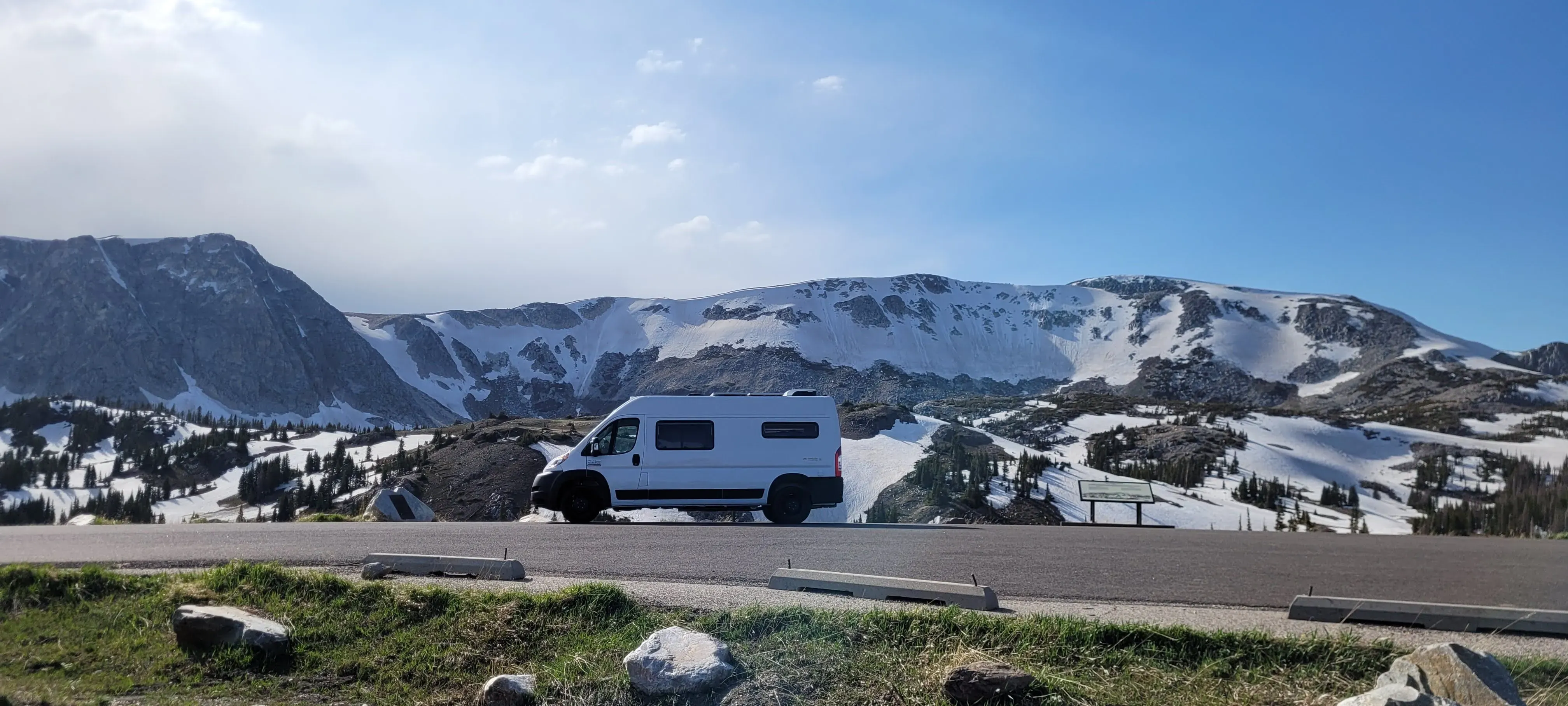
Transitioning into Spring: De-Winterizing Your Camper Van
Step-by-Step Guide to De-Winterizing
Before you know it, the sun will be shining again and it will be time to hit the road! When spring arrives, it's time to prepare your camper van for the upcoming adventures.
Follow these steps to de-winterize your camper van:
- Flush and sanitize the water system: Use fresh water to flush out the RV antifreeze and sanitize the entire water system.
- Reinstall the battery: If you removed the battery for storage, reinstall it and ensure it's fully charged.
- Check tires and brakes: Inspect the tires for any signs of damage, and check the brake system for optimal functionality.
- Remove external cover: If you used a cover or tarps for winter storage, remove and clean them, and store properly for future use.
- Inspect the interior: Check for any signs of pests or mold. Clean and air out the interior thoroughly.
Inspecting and Preparing for the New Season
Before hitting the road for your next season of exploration, conduct a comprehensive inspection of your camper van:
- Check all fluid levels: Ensure that oil, brake fluid, and other essential fluids are at the recommended levels.
- Inspect the engine: Look for any signs of wear or damage, and address issues promptly.
- Test all systems: Check the functionality of the electrical, heating, and cooling systems. Review safety equipment: Verify that fire extinguishers, smoke detectors, and other safety equipment are in good working order.
Overall, winterizing your camper van is a proactive measure to protect your investment and will make hitting the road in the spring faster and safer. By following this step-by-step winterizing guide, you'll be able to relax over the winter knowing your van is clean and safely stored. Review the considerations for storing your campervan, so you can seamlessly transition back into action when spring arrives.
Want to learn more about Noovo vans or ready to design your own? Get in touch with us today!

Written by
Keller is a copywriter and storyteller, bringing narratives of adventure-driven brands to life.
Published on February 04, 2025
Want to read more ?
Discover similar content with these recommended articles.
